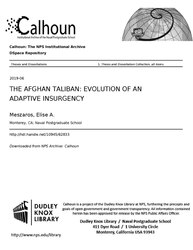File:THE AFGHAN TALIBAN- EVOLUTION OF AN ADAPTIVE INSURGENCY (IA theafghantaliban1094562833).pdf

Original file (1,275 × 1,650 pixels, file size: 761 KB, MIME type: application/pdf, 82 pages)
Captions
Captions
Summary[edit]
| THE AFGHAN TALIBAN: EVOLUTION OF AN ADAPTIVE INSURGENCY
( |
||
|---|---|---|
| Author |
Meszaros, Elise A. |
|
| Title |
THE AFGHAN TALIBAN: EVOLUTION OF AN ADAPTIVE INSURGENCY |
|
| Publisher |
Monterey, CA; Naval Postgraduate School |
|
| Description |
Throughout their twenty-five-year insurgency, the Afghan Taliban have evolved from a small group of madrasa students, mujahedeen fighters, and tribal Afghans into one of the most innovative and adaptive insurgencies in modern history. As a result, the U.S.-declared War on Terror in Afghanistan has persisted for eighteen years as the Afghan Taliban continue to threaten regional security and stability. In 2019, renewed Taliban peace talks with the U.S. may be an indicator for optimism, but the historical patterns in Taliban strategy and ideology demand caution. The U.S. government has repeatedly underestimated the sophistication, innovation, and resiliency of the Taliban. This thesis examines how the Afghan Taliban’s strategies and ideologies have evolved since 1994 when the group became an explicit political and military entity. Broken into distinct time periods, this thesis chronologically investigates the history of the insurgency using the following lenses: Afghan identity, the spread of transnational terrorism, tactical innovation, and political ingenuity. Outdated and over-generalized counterinsurgency doctrine led to millions of American deaths in Vietnam, Afghanistan, and Iraq. Success of future doctrine requires applied awareness of cultural complexities and adversarial behaviors. Agility, speed, and responsiveness must become major tenets of counterinsurgency planning moving forward. Subjects: Afghan Taliban; insurgency; counterinsurgency; Afghanistan; anti-Soviet jihad; United States; adaptation; evolution; political ingenuity; tactical innovation; Afghan identity; transnational terrorism; jihad; Mullah Omar; Osama bin Laden; al-Qaeda; peace talks |
|
| Language | English | |
| Publication date | June 2019 | |
| Current location |
IA Collections: navalpostgraduateschoollibrary; fedlink |
|
| Accession number |
theafghantaliban1094562833 |
|
| Source | ||
| Permission (Reusing this file) |
This publication is a work of the U.S. Government as defined in Title 17, United States Code, Section 101. Copyright protection is not available for this work in the United States. | |
Licensing[edit]
| Public domainPublic domainfalsefalse |
This work is in the public domain in the United States because it is a work prepared by an officer or employee of the United States Government as part of that person’s official duties under the terms of Title 17, Chapter 1, Section 105 of the US Code.
Note: This only applies to original works of the Federal Government and not to the work of any individual U.S. state, territory, commonwealth, county, municipality, or any other subdivision. This template also does not apply to postage stamp designs published by the United States Postal Service since 1978. (See § 313.6(C)(1) of Compendium of U.S. Copyright Office Practices). It also does not apply to certain US coins; see The US Mint Terms of Use.
|
 | |
| This file has been identified as being free of known restrictions under copyright law, including all related and neighboring rights. | ||
https://creativecommons.org/publicdomain/mark/1.0/PDMCreative Commons Public Domain Mark 1.0falsefalse
File history
Click on a date/time to view the file as it appeared at that time.
| Date/Time | Thumbnail | Dimensions | User | Comment | |
|---|---|---|---|---|---|
| current | 03:47, 25 July 2020 |  | 1,275 × 1,650, 82 pages (761 KB) | Fæ (talk | contribs) | FEDLINK - United States Federal Collection theafghantaliban1094562833 (User talk:Fæ/IA books#Fork8) (batch 1993-2020 #29123) |
You cannot overwrite this file.
File usage on Commons
The following page uses this file:
Metadata
This file contains additional information such as Exif metadata which may have been added by the digital camera, scanner, or software program used to create or digitize it. If the file has been modified from its original state, some details such as the timestamp may not fully reflect those of the original file. The timestamp is only as accurate as the clock in the camera, and it may be completely wrong.
| Short title | THE AFGHAN TALIBAN: EVOLUTION OF AN ADAPTIVE INSURGENCY |
|---|---|
| Image title | |
| Author | Meszaros, Elise A. |
| Software used | Meszaros, Elise A. |
| Conversion program | Adobe PDF Library 15.0 |
| Encrypted | no |
| Page size | 612 x 792 pts (letter) |
| Version of PDF format | 1.4 |

